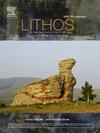Chemical and boron isotope composition of multiple generations of tourmaline from the Nassarawa lithium-rich pegmatites, Nigeria: Implications for the mechanism of lithium enrichment
IF 2.9
2区 地球科学
Q2 GEOCHEMISTRY & GEOPHYSICS
引用次数: 0
Abstract
Pegmatites are the primary global source of rare metal lithium (Li). While previous studies highlight the importance of high granitic magma differentiation in the formation of lithium-rich pegmatites, the processes and timescales of magmatic fractionation remain unclear. Specifically, it is uncertain whether lithium-rich melts originate from multiple magmatic pulses or a single continuous fractional crystallization event. This study presents elemental mapping, in-situ trace element analysis, and boron isotope data for four generations of tourmaline sourced from the lithium mineralization of the Nassarawa-Keffi pegmatitic belt in Nigeria. Tourmaline grains intergrowth with plagioclase, quartz, and K-feldspar, display compositional zoning and resorption-precipitation textures, indicating incremental growth predominantly influenced by the injection of multistage magma batches. The notable periodic increases in Li and Mn contents, accompanied by decreases in Fe, as well as the distinct variation trends in the Li/Sc, Li/K, and Li/Ge ratios across the four tourmaline generations, suggest the involvement of at least four distinct melt pulses. The narrow δ11B values observed across all tourmaline generations indicate a single magmatic source. The observed decrease in δ11B values in the later tourmaline generations is likely due to fluid exsolution and mineral crystallization processes. Subsequent magma pulses exhibit higher lithium concentrations than earlier, suggesting that multistage melt pulses and high fractional crystallization within a deep magmatic reservoir are essential for lithium enrichment in the Nassarawa lithium-rich pegmatites. Based on these findings, we propose an alternative model in which multiple melt-release events from a single cooling magmatic reservoir contribute to the formation of lithium-rich pegmatites.
求助全文
约1分钟内获得全文
求助全文
来源期刊

Lithos
地学-地球化学与地球物理
CiteScore
6.80
自引率
11.40%
发文量
286
审稿时长
3.5 months
期刊介绍:
Lithos publishes original research papers on the petrology, geochemistry and petrogenesis of igneous and metamorphic rocks. Papers on mineralogy/mineral physics related to petrology and petrogenetic problems are also welcomed.
 求助内容:
求助内容: 应助结果提醒方式:
应助结果提醒方式:


